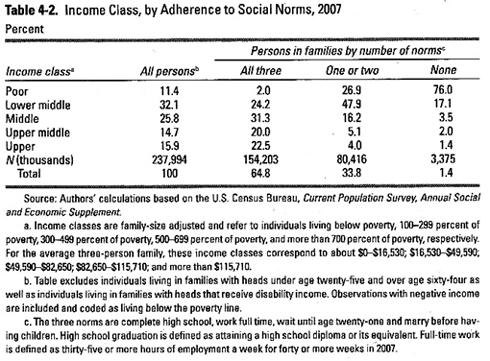December 05, 2012
Ross Douthat writes: “Rick Santorum’s … campaign trail riff about how much people improve their odds of staying out of poverty just by graduating from high school, taking full-time work and (above all) getting married before having kids has pretty solid data behind it.” (Santorum’s specific argument, as he put it in his RNC speech, was that “if you don’t do these three things you’re 38 times more likely to end up in poverty” compared with people who do all three of them.)
Actually, Santorum’s three-things argument is a gross distortion of economic insecurity in the United States. One designed, much in the same way as the infamous makers vs. takers argument (which Santorum also obliquely referenced in his speech), to divide Americans and blame working-class people for being economically insecure.
Let’s review some of the facts:
- The three-things argument implies that most adults living in poverty didn’t bother to graduate from high school. However, if we look at actual data, as I did in this post, it turns out that the vast majority of adults with below-poverty incomes—7 out of every 10—are high school graduates. And more than one out of every three have a college degree or some education beyond high school. One of the more notable things about poverty trends since the 1970s—and something you never hear from Very Serious People—is that poverty has remained high in recent decades despite a large increase in educational attainment. As a result, people living below the poverty line today are better educated than ever —in 1979, only about 4 in 10 had a high school degree.
- The three-things argument implies that most parents of children living below the poverty line aren’t married. But, as I recently detailed, about 1 out of every 2 are, um, married. Only 39 percent of parents in poverty have never been married. A related point here: the argument implies that it is marriage before having a child that matters most, but we know from other research that young mothers who marry shotgun style have high divorce rates, and they and their children often end up worse off than young mothers who don’t rush to get married. As demographer Andrew Cherlin has argued, the best advice to give young people isn’t “get thee married!”, it’s slow down when it comes to family formation, even if that means not rushing into marriage or remarrying if you’re a single parent.
- Because it has never been adjusted for increases in typical living standards, the federal poverty line has “defined deprivation down” over the last several decades. This skews our picture of poverty in a way that plays into makers vs. takers arguments like Santorum’s three things. If we use a contemporary poverty line, one adjusted to equal the same percentage of median income as the original poverty line (about $34,000 for a family of four), the already high share of adults in poverty who have high school diplomas and/or are married increases even more.
- Among the most relevant and pressing poverty risks today is the decline in middle-class jobs. This isn’t just an individual risk, it’s one that affects the health of our entire economy—when workers aren’t compensated adequately to spend enough on the basics, our whole economy suffers. Very Serious People should spend more time worrying about the impact that the decline of labor unions has had on families and less time worrying about marital unions.
- Another especially relevant and pressing poverty risk today involves raising children. Married, middle-aged people are not magically protected from this risk. As I’ve shown, among married prime-age adults, those caring for children are 56 percent more likely to be living below $34,000 (the contemporary poverty line), than those not caring for children. There are more impoverished, married parents with children in this age group (5.7 million) than there are people who haven’t done any of Santorum’s three things. So, maybe Very Serious People should spend more time thinking about them.
- Finally, Bob Dole’s appearance on the Senate floor yesterday, in an unsuccessful attempt to get more than a handful of conservatives to support the Convention on the Rights of Persons with Disabilities, reminded me of the extent to which Very Serious People here in D.C. don’t take disability into account when talking about poverty. According to Census annual poverty data for 2011, adults with disabilities are more than twice as likely to be impoverished as non-disabled adults. But at a recent Brookings Institute event on the 2011 poverty data, marriage was mentioned seven times, while disability was never mentioned. (For more on the poverty-disability connection, see my 2009 paper).
Why the failure to take disability into account among very serious people? Probably because it would make it harder to blame working-class people for their own economic insecurity. Btw, guess who has spoken out in opposition to Dole and the Convention? I’ll give you a hint: his last name starts with an S.
So by now you are probably asking what is the “solid data” Douthat points to behind Santorum’s three things? It comes from a 2009 book by Ron Haskins and Isabel Sawhill. The specific data is in Table 4-2 on page 71 of the book, which I’ve pasted below. Here Haskins and Sawhill divide up Americans into what they call norm-abiding and norm-violating groups. (See what I mean about this being the Very Serious Person’s version of makers vs. takers?) Santorum’s 38 percent times more likely number comes from comparing the 76 percent poverty rate for the most decadent norm-violators, those in the “none” column, with the 2 percent poverty rate for the most saintly norm-abiders in the “all three” column. Based on this, Santorum, Douthat, and Haskins/Sawhill argue that if the most decadent norm violators simply became saintly norm abiders, most of them would, as Haskins/Sawhill put it: “achieve the American Dream.”

The problem with this conclusion becomes evident, however, when you note how few people are actually decadent norm violators (in the None column) compared to the other two columns. My figure below shows the numbers. The 76 percent poverty rate for the 3.4 million people in the decadent None column accounts for only 2.6 million people in families in poverty. By comparison, the 2 percent poverty rate for the 154.2 million people in most saintly column accounts for 3.1 million people in poor families. So, there are more saintly norm abiders in poverty than there are decadent norm violators. And, the vast majority (about 80 percent) of people in poverty (along with millions of other Americans in the upper and middle classes) are neither perfect saints nor perfect sinners.
Impoverished Working-Age People in Families by “Adherence to Social Norms,” 2007

Number (Thousands)
So, if we want to be actually serious about reducing poverty and economic insecurity, it would be a good idea to focus on the things that contribute to impoverishment at all of the points on the abiding-violating continuum, like creating jobs that compensate workers adequately and strengthening social insurance programs, especially for parents.
Another problem involves the mashing up of the three things, when maybe just looking at one would be more informative. In fact, in the text that accompanies Table 4-2, Haskins-Sawhill note that looking at each norm separately, working full time has the strongest association with avoiding poverty (they don’t, as Douthat does, say that it is marriage “above all” that makes the difference).
The importance of jobs, of course, is not surprising, especially given the extent to which the obsolete poverty line has defined deprivation since the 1960s. But it is also worth noting that although Santorum/Douthat and others have talked about the three things as if they were universally applicable, the data in the table are actually for 2007, when unemployment was 4.6 percent, rather than 8 percent.
Finally, the three-things analysis rigidly and narrowly defines norm-violating in a (fairly offensive) way that doesn’t give any credit for the many forms that virtue can take. So, for example, according to the three-things analysis, you are a norm-violator if, for example, during the last year, you did any of the following without working full-time, year-round: 1) were laid off after working for 39 (or fewer) weeks during the year, and spent the rest of the weeks searching diligently for work; 2) went to college or other school; 3) were unable to work because of a disability (Haskins/Sawhill exclude people receiving SSI or SSDI from their analysis, but many people with disabilities, especially non-permanent ones do not receive these benefits, and the data source they use substantially undercounts receipt of the disability benefits); 4) cared for a severely disabled child, elderly family member, or your spouse who is a veteran, just got back from Afghanistan, and were suffering from post-traumatic stress syndrome; or 5) worked 32 hours a week, year-round at Wal-Mart and spend 10 hours a week as a volunteer at your church or child’s school.
In summation, the world has changed. Unless Very Serious People want to keep sounding like your cranky old Uncle Murray (if you’re a white, middle-age person who grew up in the 80s with an elderly family member who sounded a lot like Charles Murray), they need to change, too.






